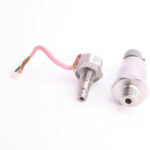There are a number of industries in which machinery must meet stringent specifications in order to be approved for application in that area. And one of the most common of these is the food or chemical industry in which no “dead” pockets can be accepted. All sensors must be installed flush with the inside wall to ensure that machinery can be fully cleaned and no germs or bacteria can survive.
There are several sensor manufacturers on the market that are able to meet these requirements, and there are two different approaches: oil-filled sensors and non-oil-filled sensors.
Oil-filled sensors
Manufacturers of oil-filled sensors start with a simple low-cost sensor, add an external diaphragm on the front and fill the cavity with oil, silicone etc. In operation, pressure on the external diaphragm puts pressure on the oil, which deflects the sensor’s own diaphragm. In order for this to work correctly, the external diaphragm must be thin and not incorporate any stiffness (which would not allow the pressure to be reflected). Therefore such devices are generally large and thin.
Secondly, because of the oil-filled cavity, the temperature characteristics of the oil can have a huge effect, and in order to keep it all together there can be several O-ring seals.
Lastly, if the diaphragm breaks, you will have oil in your media or all over the shop floor.
Non-oil-filled sensors
The non-oil-filled device is a true flush diaphragm with the gauge directly behind the diaphragm. These sensors are generally more expensive, but can withstand much higher burst pressures (because of their thicker diaphragms). Temperature characteristics can still cause problems, and so it is wise to check with the manufacturer.
Generally, either type of flush diaphragm pressure sensor can be used in any given application, but as always there are advantages and disadvantages to each type.
Compared with other types of sensors, when a flush diaphragm is needed it is important to investigate all options of ranges, fittings, specifications, stainless-steel requirements, cost etc. However, don’t just look at cost: in applications like these you will definitely get what you pay for.
Read more: Index to all of our Technical Notes on Pressure
Have a pressure application you want to discuss? Let us call you…
Why Us?
- Suppliers of top quality strain gauge sensors and transducers to every corner of industry – UK and worldwide
- Over 100 years of expert transducer knowledge
- Our high quality products all come with a 3 year warranty





